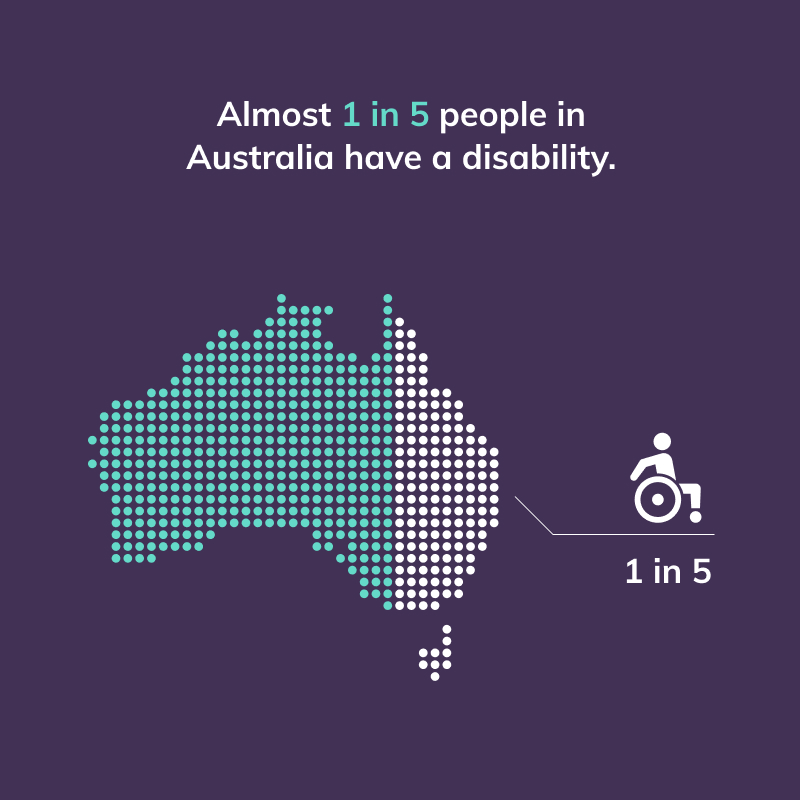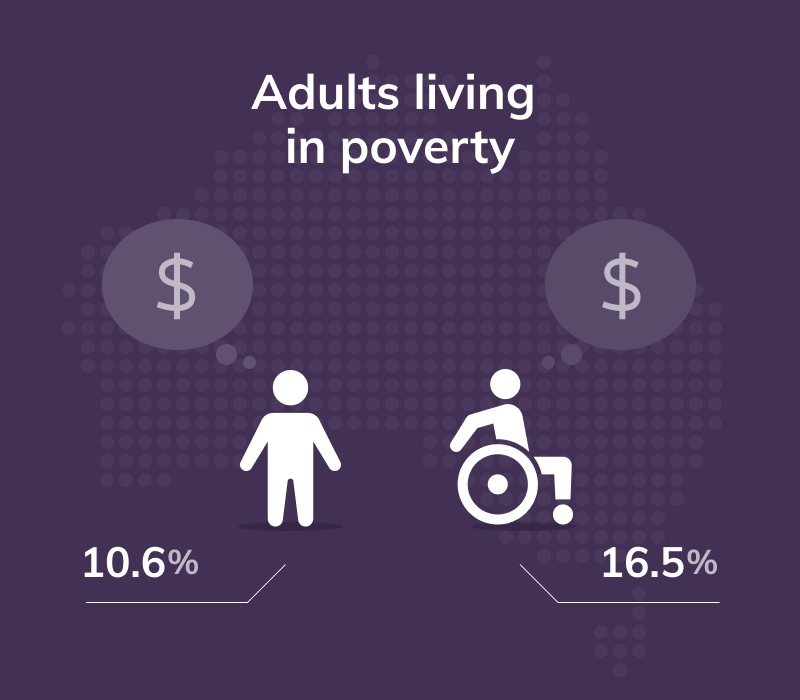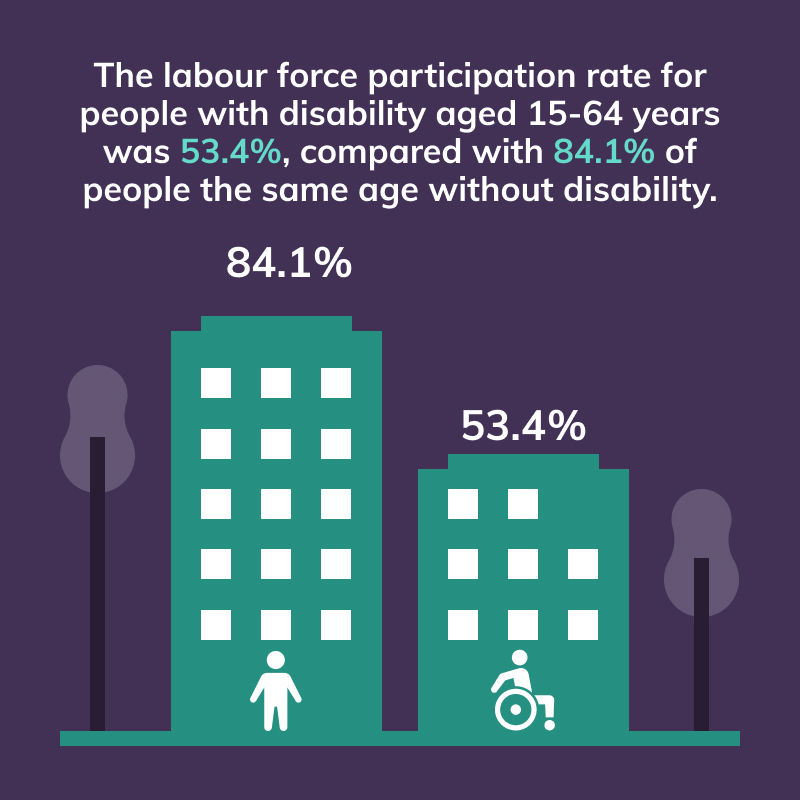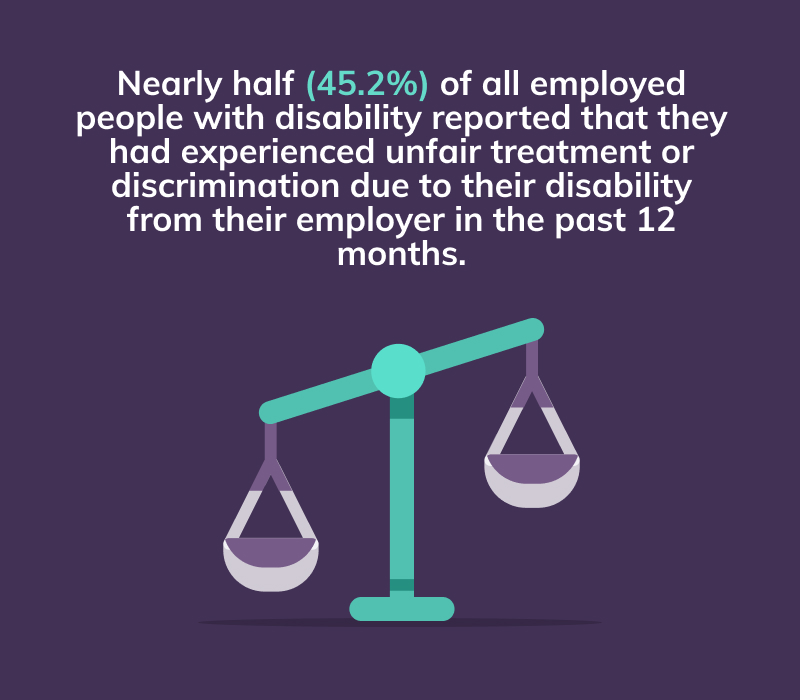Disability and employment in Australia

Download the 'Disability and employment in Australia' PDF factsheet (523 KB)
Download the ‘Disability and employment in Australia' DOC factsheet (971 KB)
1. Overview
This factsheet provides information on:
- disability in Australia
- disability and education in Australia
- the employment of people with disability in Australia
- employment and disability discrimination in Australia.
2. Disability in Australia
There are 4.4 million people with disability in Australia, comprising 17.7% of the population.[1] The prevalence of disability is similar for males (17.6%) and females (17.8%).[2]
In Australia:
- 16.5% of adults with disability live in poverty compared to 10.6% of adults without a disability[3]
- people with disability make up 37.9% of the population living in poverty (despite only making up 18% of the overall population).[4]
Over a third of people with disability of working age (15-64 years) rely on a government pension or allowance as their main source of income.[5]
People with disability are less likely to complete Year 12 or equivalent, than people without disability.
3. Disability and education in Australia
Approximately 10% of Australian school students aged 5–18 years have a disability, and most (89%) attend a mainstream school.[6]
For all Australians with disability aged 20 years and over:
- around 1 in 3 (34%) have completed Year 12 or equivalent[8]
For all Australians without disability aged 20 years and over:
- around 2 in 3 (66%) have completed Year 12 or equivalent[9]
- close to 35% have completed a bachelor’s degree or higher.[10]
It is important to note, however, that the above statistics differ considerably when focusing on recent school leavers. Of those aged 20–24 years with a disability, 68% have completed Year 12 or equivalent compared with 85% of young people without a disability.[11]
Around 7.3% of new university enrolments in 2018 were comprised of people with a disability. This percentage is steadily increasing each year. Since 2012, Australian university enrolments from people with a disability have increased by 64.9%, compared with general enrolment growth of 18.6%.[12]
As of 2019, 67% of undergraduates with a disability were employed full-time, compared with 73% of undergraduates without a disability.[13]
4. Employment of people with disability
The labour force participation rate[14] for people with disability aged 15–64 years is 53.4%, compared to 84.1% of people the same age without disability.[15]
The labour force participation rate for people with disability has remained largely unchanged from 2003 (53%) to 2018 (53.4%).[16] In contrast, the labour force participation rate for people without disability increased from 63.6% (2003) to 84.1% (2018).[17]
In summary, the labour force participation rate has remained relatively unchanged for people with disability over the last 20 years.[18]
People with disability are also more likely to be employed on a part time basis, than people without disability.
In Australia, for people with disability of working age (15–64 years) in the labour force:
- close to 59.1% are employed on a full-time basis, compared to 68.3% of people without disability[19]
- approximately 40.9% are employed on a part-time basis, compared to 31.7% of people without disability.[20]
5. Employment and disability discrimination
In the most recent data from the Australian Bureau of Statistics, nearly half (45.2%) of all employed people with disability reported that they had experienced unfair treatment or discrimination from their employer due to their disability in the past 12 months.[21]
In 2019–2020, the Australian Human Rights Commission (the Commission) received a total of 2,307 complaints.[22] Consistent with previous years, the main areas of public life raised by complainants were employment and access to the provision of goods, services and facilities.[23] Almost half (44%) of these complaints were made under the Disability Discrimination Act 1992 (Cth), with close to a third (30%) of these complaints relating to employment.[24]
Willing to Work: National Inquiry into Employment Discrimination Against Older Australians and Australians with Disability
In 2015, the Attorney-General asked the Age and Disability Discrimination Commissioner, on behalf of the Commission, to undertake the Willing to Work: National Inquiry into Employment Discrimination Against Older Australians and Australians with Disability (the Inquiry).
The Terms of Reference for the Inquiry required the Commission to examine practices, attitudes and Commonwealth laws that deny or diminish equal participation in employment and make recommendations to address employment discrimination against older Australians and Australians with disability.[25]
The Inquiry Report was released in May 2016. Its key findings included the following:
- Discrimination is underpinned by negative assumptions and attitudes that are held by many employers and throughout the community about the productivity and capability of people with disability and perceptions that they present a higher work health and safety risk.[26]
- Employers may lack knowledge, awareness and skills to develop inclusive workplaces, implement recruitment and retention strategies to support people with disability and meet their legal and regulatory requirements. They may also be unaware of government programs and supports that can assist them.[27]
- People with complex and intersecting disabilities can face more barriers in the workplace and more forms of discrimination.[28]
- Individuals who are subject to negative assumptions, stereotypes and discrimination can experience stress, and a decline in physical and mental health.[29]
The experience of discrimination can also diminish a person’s self-confidence, self-esteem and motivation to remain in the workforce.[30]
Endnotes
[1] Australian Bureau of Statistics, Survey of Disability, Ageing and Carers, Summary of Findings 2018 (Catalogue No 4430.0, 24 October 2019).
[2] Australian Bureau of Statistics, Survey of Disability, Ageing and Carers, Summary of Findings 2018 (Catalogue No 4430.0, 24 October 2019).
[3] ACOSS and UNSW Sydney, Poverty in Australia 2018 (Report, 2018) 59 .
[4] ACOSS and UNSW Sydney, Poverty in Australia 2018 (Report, 2018) 25 .
[5] Australian Bureau of Statistics, Disability, Ageing and Carers, Australia: Summary of Findings, 2018 (Catalogue No. 4430.0, 24 October 2019).
[6] Australian Institute of Health and Welfare, People with disability in Australia 2020: in brief (Cat. no. DIS 77, October 2020) .
[7] Australian Institute of Health and Welfare, People with Disability in Australia (Cat no DIS 72, 2 October 2020).
[8] Australian Institute of Health and Welfare, People with Disability in Australia (Cat no DIS 72, 2 October 2020).
[9] Australian Institute of Health and Welfare, People with Disability in Australia (Cat no DIS 72, 2 October 2020.
[10] Australian Institute of Health and Welfare, People with Disability in Australia (Cat no DIS 72, 2 October 2020).
[11] Australian Institute of Health and Welfare, People with disability in Australia 2020: in brief (Cat. no. DIS 77, October 2020).
[12] Australian Disability Clearinghouse on Education and Training, Higher Education Statistics (2019).
[13] Australian Disability Clearinghouse on Education and Training, Higher Education Statistics (2019).
[14] The labour force participation rate is the sum of working-age (aged 15-64) people who are employed or unemployed and looking for work as a percentage of the working-age population. See: Australian Institute of Health and Welfare, People with Disability in Australia (Cat no DIS 72, 2 October 2020).
[15] Australian Bureau of Statistics, Disability, Ageing and Carers, Australia: Summary of Findings, 2018 (Catalogue No. 4430.0, 24 October 2019).
[16] See, Australian Bureau of Statistics, Disability, Ageing and Carers, Australia: Summary of Findings, 2003 (Catalogue No. 4430.0, 15 September 2004); Australian Bureau of Statistics, Disability, Ageing and Carers, Australia: Summary of Findings, 2018 (Catalogue No. 4430.0, 24 October 2019).
[17] See, Australian Bureau of Statistics, Australian Labour Market Statistics, Jan 2005 (Catalogue No 6105.0, 7 January 2005); Australian Bureau of Statistics, Disability, Ageing and Carers, Australia: Summary of Findings, 2018 (Catalogue No. 4430.0, 24 October 2019).
[18] See for example, in 1998, the labour force participation rate of people with disability was 46.5%. Australian Bureau of Statistics, Disability, Ageing and Carers, Australia: Summary of Findings, 1998 (Catalogue No. 4430.0, 21 April 1999).
[19] Australian Institute of Health and Welfare, People with Disability in Australia (Cat no DIS 72, 2 October 2020).
[20] Australian Institute of Health and Welfare, People with Disability in Australia (Cat no DIS 72, 2 October 2020).
[21] Australian Bureau of Statistics, Disability, Ageing and Carers, Australia: Summary of Findings, 2018 (Catalogue No. 4430.0, 24 November 2019).
[22] Australian Human Rights Commission, 2019-20 Complaint Statistics (2020) 2.
[23] Australian Human Rights Commission, 2019-20 Complaint Statistics (2020) 2.
[24] Australian Human Rights Commission, 2019-20 Complaint Statistics (2020) 2.
[25] Australian Human Rights Commission, Willing to Work – Terms of Reference for the Inquiry (June 2015).
[26] Australian Human Rights Commission, Willing to Work: National Inquiry into Employment Against Older Australians and Australians with Disability (Report, May 2016) 12.
[27] Australian Human Rights Commission, Willing to Work: National Inquiry into Employment Against Older Australians and Australians with Disability (Report, May 2016) 12 .
[28] Australian Human Rights Commission, Willing to Work: National Inquiry into Employment Against Older Australians and Australians with Disability (Report, May 2016) 71‑74.
[29] Australian Human Rights Commission, Willing to Wok: National Inquiry into Employment Against Older Australians and Australians with Disability (Report, May 2016) 12.
[30] Australian Human Rights Commission, Willing to Work: National Inquiry into Employment Against Older Australians and Australians with Disability (Report, 2016) 12.
|
This guide is part of a suite of resources developed by the Australian Human Rights Commission as part of IncludeAbility to assist:
Explore our other Disability Employment resources. |





